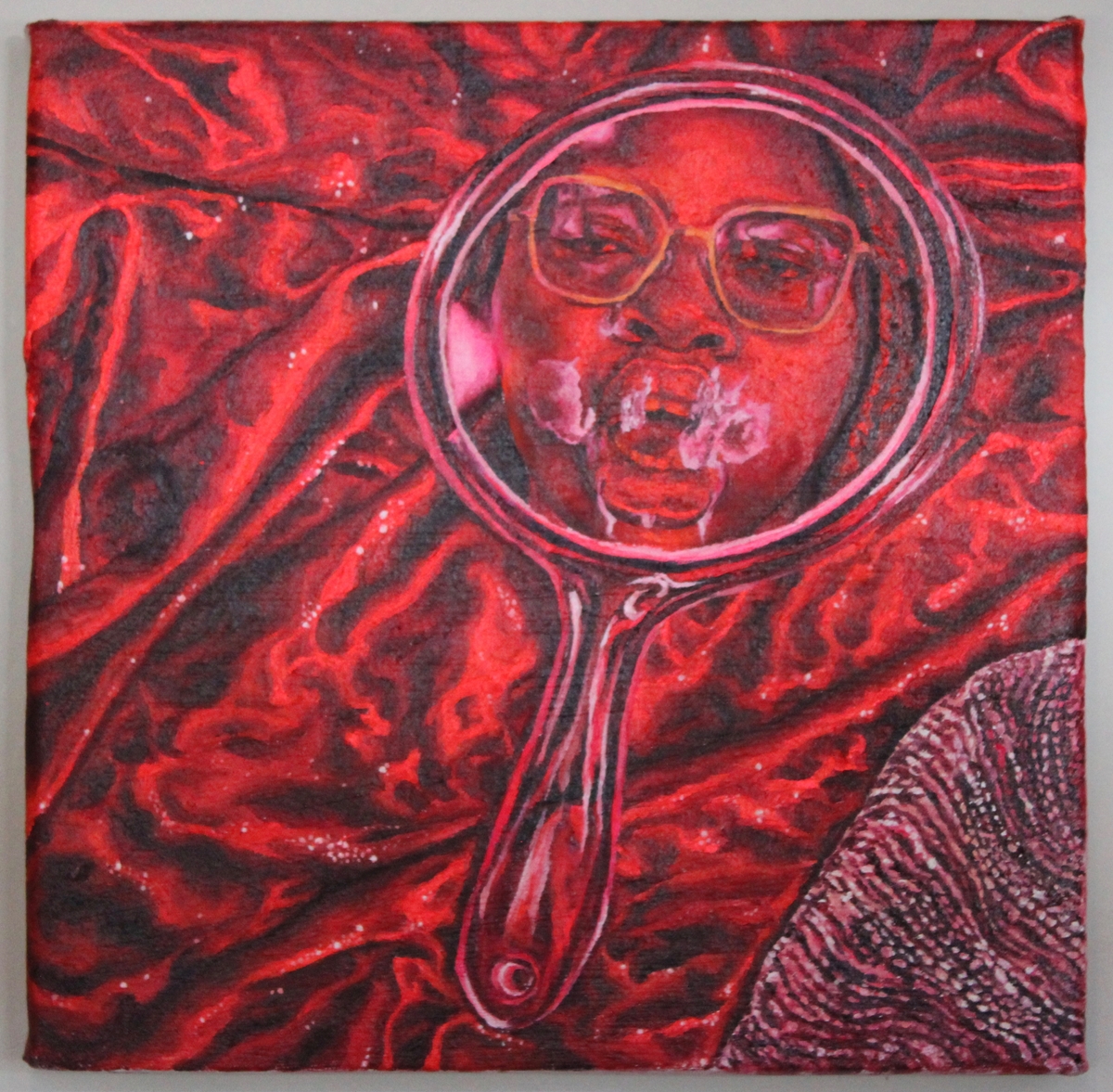
Autumn Nelson
Self-Indulgence.
Autumn Nelson’s canvas is the first piece in “The Past Pushes Forward” — an art show installed in the top floor of the Blake Hotel at 9 High St., now until August 31 — to greet viewers as they exit the elevator. It’s hung in just the right spot so that the canvas functions as a double of the subject matter. The mirror that reflects the painter is held up to the viewer as well. Do we love ourselves as much as Nelson loves herself? How much are we allowed to love ourselves? Why is it fraught to even ask that question?
It turns out Nelson’s journey of self-love has a specific context, too. “Nelson’s work tackles the concept of Sologamy — the act of dating one’s self,” an accompanying note explains. “She creates romanticized scenes of her journey to self love, studying moments of solitude, self analysis with the use of double self portraits, and the effects of the reflections from the male antagonist figure. With her use of high key reds along with pinks and greens, she transforms cinematic moments into oil base mediums invoking a mood-altering atmosphere.”
The initial pleasure and the depth of Nelson’s painting are emblematic of the show, curated by Omola Studio, which offers a welcome chance to reflect beneath the cheery surface. “The artists featured in this exhibition express their experiences and invite viewers to connect with their own,” an accompanying note states. “Some of the works are raw and visceral, while others are more subtle and introspective. All of them, however, offer a space for contemplation and reflection. Through ‘The Past Pushes Forward’ exhibition we hope you sit with each artist’s works, allowing for a safe and nurturing environment in which you can explore your own personal landscape. We believe that art has the power to help us connect with ourselves and with others, and we invite you to join us on this journey to consider the ways in which our emotions, desires, and experiences are shaped by the world around us.”

Jeff Ostergren
Likewise, Jeff Ostergren’s canvases are both scintillating and serious. “Ostergren explores the intertwined histories of pharmaceuticals and color,” a note explains. “His pointillist, color-saturated paintings, sculptures, and videos incorporate actual pharmaceuticals and chemicals, using imagery from art history and advertising to delve into the complexities of our current moment. The concept of the ‘pharmakon,’ a Greek term encompassing cure, poison, and paint, serves as a central theme in his work. Each molecule of pigment or drug, whether pleasurable and mind-altering, physically toxic, or both, carries the entire narrative of its invention, production, marketing, and consumption. In his painting, he draws inspiration from pharmaceutical advertising that strikingly references art historical works, particularly from the Impressionist era, which coincided with the rise of synthetic chemistry. These images of idealized leisure offer a powerful lens through which to examine representations of race, gender, sexuality, class, and disability.”
Ostergren’s paintings point out how, first off, the social conversation about drugs still lags far behind their experienced reality. Depending on the context, drugs are often either fun and possibly mind-expanding, or addictive and life-destroying. Through his art, Ostergren managed to capture both of those extremes and the foggy area in between, where perhaps most of us actually dwell.

Victoria Martinez
The vivid colors in Victoria Martinez’s work, meanwhile, connect to heritage. “Martinez’s paintings and art installations produce conversations with ancient and modern architecture,” a note states. “Her mark making combines the durability of materials including bricks with the suppleness of textiles and the fluidity of paint. Contesting fabric’s traditional associations with craft and the decorative, she transforms swaths of cloth into structural elements as a way of honoring Latin American culture. Attentive to the histories of place, she also creates works that bear indexical relationships with locations. Martinez builds tangible connections with her familial, Mexican ancestry and investigates sites as repositories of cultural memory.” The emphasis on color reminds the viewer that, amid the Blake Hotel’s quiet palette, Martinez’s work — along with the other pieces in the show — have something to say.

But not all of the artists’ intentions point to a specific subject beyond the art. Noé Jimenez keeps it more abstract. “Jimenez considers his paintings similar to weavings, their dense paper substrates are built up and cut back in layers,” a note relates. “The physical and performative nature of the work creates spontaneous objects that are in perpetual growth, movement, and variation. The spaces created are clumsy and comedic — a recollection of memories in the form of colors and textures.” Jimenez’s sense of movement appears in all the works in the show, which, even in the contexts of their subjects, carry feelings of growth and change, starting with the idea of finding art beyond galleries, and ways to explore thoughts and feelings even in places where you might otherwise be passing through.